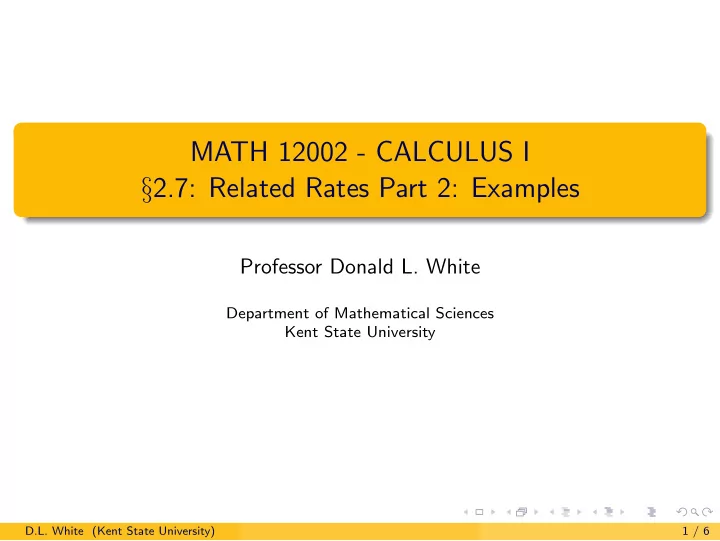

MATH 12002 - CALCULUS I § 2.7: Related Rates Part 2: Examples Professor Donald L. White Department of Mathematical Sciences Kent State University D.L. White (Kent State University) 1 / 6
Examples Example 2 Sand is being poured onto a pile at a rate of 1 . 5 cubic feet per minute in such a way that it forms a cone whose height is equal to its radius. How fast is the height increasing when the pile is 5 feet high? Solution We are given the rate of change of volume of the sand and need to determine the rate of change of the height of the pile. We let V = volume of the sand at time t, h = height of the pile at time t. Given: dV dt = 1 . 5 ft 3 / min. Want: dh dt when h = 5 ft. We need to relate V and h and then take derivatives with respect to time in order to relate dV dt and dh dt . [Continued → ] D.L. White (Kent State University) 2 / 6
Examples Example 2 Solution [continued] The volume of a cone is given by V = 1 3 π r 2 h , where r is the radius of the (circular) base and h is the height. We are given that the height of the pile is equal to its radius, hence r = h and V = 1 3 π h 3 . Taking derivatives with respect to time, we have dV dt = 3 · 1 3 π h 2 dh dt = π h 2 dh dt . Therefore, when h = 5 , dh 1 . 5 3 dt = π · 5 2 = 50 π ft/min ≈ . 019 ft/min . D.L. White (Kent State University) 3 / 6
Examples Example 3 A helium balloon is released on the ground 35 feet from an observer and rises vertically. If the angle between the line of sight and the ground is increasing at a rate of 0 . 5 radians per minute, how fast is the balloon rising when it is 49 feet off the ground? Solution We let θ = angle between line of sight and ground at time t, B = altitude of the balloon at time t. Given: d θ dt = 0 . 5 rad / min. Want: dB dt when B = 49 ft. We need to relate B and θ and then take derivatives with respect to time in order to relate dB dt and d θ dt . [Continued → ] D.L. White (Kent State University) 4 / 6
Examples Example 3 Solution [continued] We have the following situation at a given time: ✑ BALLOON q ✑✑✑✑✑✑ B ✻ θ OBSERVER q 35 ft Since this is a right triangle, we have tan θ = B 35 , or B = 35 tan θ. Taking derivatives with respect to time, we obtain dB dt = 35(sec 2 θ ) d θ dt . [Continued → ] D.L. White (Kent State University) 5 / 6
Examples Example 3 Solution [continued] We have dB dt = 35(sec 2 θ ) d θ dt dt = 0 . 5 , so we need to determine sec 2 θ when B = 49 . and d θ Recalling that sec = hyp adj and using the Pythagorean Theorem, we have √ √ √ √ 35 2 + 49 2 7 2 · 5 2 + 7 2 · 7 2 5 2 + 7 2 = 7 74 sec θ = = = 5 . 35 35 35 Therefore, when B = 49 , � √ � 2 dB 74 (0 . 5) = 35 · 74 25 · 2 = 7 · 37 = 259 dt = 35 = 51 . 8 ft/min. 5 5 5 D.L. White (Kent State University) 6 / 6
Recommend
More recommend